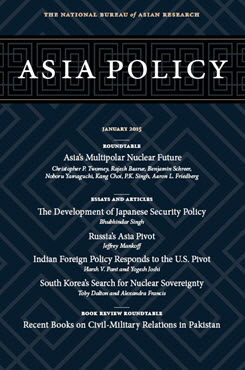China's Development of a More Secure Nuclear Second-Strike Capability
Implications for Chinese Behavior and U.S. Extended Deterrence
This is one of seven essays in the roundtable “Approaching Critical Mass: Asia’s Multipolar Nuclear Future.”
Benjamin Schreer is Senior Analyst for Defence Strategy at the Australian Strategic Policy Institute.
This is one of seven essays in the roundtable Approaching Critical Mass: Asia’s Multipolar Nuclear Future.
The People’s Republic of China (PRC) is in the midst of improving its nuclear arsenal, both quantitatively and qualitatively. Since the details of this nuclear modernization process remain clouded in secrecy, estimates of the numbers of China’s nuclear warheads vary significantly. Pessimists believe that Beijing could possess well over 1,000 warheads, most of which are assumed to be hidden in a complex system of underground tunnels. [1] In contrast, this essay agrees with conservative assessments that the total size of China’s nuclear arsenal is approximately 250 warheads, delivered by land-based ballistic missiles, aircraft, and an emerging ballistic submarine fleet. The U.S. intelligence community expects that the number of these nuclear warheads capable of threatening the U.S. homeland will more than double to over 100 by the mid-2020s. [2]
China is on a long-term path of replacing its old liquid-fuel, moveable DF-3A intermediate-range ballistic missiles (IRBM) with solid-fuel, road-mobile DF-21 medium-range ballistic missiles (MRBM). The People’s Liberation Army (PLA) Navy’s Jin-class nuclear-powered ballistic missile submarine (SSBN) was also expected to conduct its first patrol by the end of 2014 while armed with the JL-2 submarine-launched ballistic missile. The PLA Navy is estimated to have three Jin-class boats, which could increase to four to five SSBNs by 2020. China is also reportedly developing a next-generation SSBN, called the Type 096. It is therefore gradually making progress toward a credible sea-based nuclear deterrent. [3]
Endnotes
[1] Phillip A. Karber, “Strategic Implications of China’s Underground Great Wall,” Georgetown University Asian Arms Control Project, September 11, 2011, http://www.fas.org/nuke/guide/china/Karber_UndergroundFacilities-Full_2011_reduced.pdf.
[2] Hans M. Kristensen and Robert S. Norris, “Chinese Nuclear Forces, 2013,” Bulletin of Atomic Scientists 69, no. 6 (2013): 797–85.
[3] U.S.-China Economic and Security Review Commission, 2014 Annual Report to Congress (Washington, D.C., November 2014), 300–302.
About Asia Policy
Asia Policy is a peer-reviewed scholarly journal presenting policy-relevant academic research on the Asia-Pacific that draws clear and concise conclusions useful to today’s policymakers. Asia Policy is published quarterly in January, April, July, and October and accepts submissions on a rolling basis. Learn more


